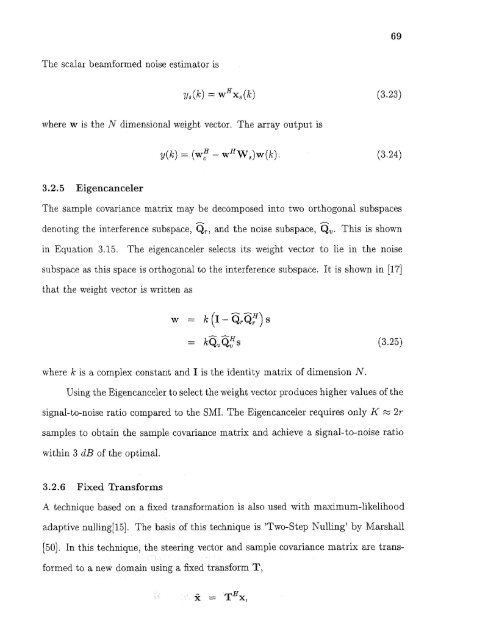Space/time/frequency methods in adaptive radar - New Jersey ...
Space/time/frequency methods in adaptive radar - New Jersey ...
Space/time/frequency methods in adaptive radar - New Jersey ...
Create successful ePaper yourself
Turn your PDF publications into a flip-book with our unique Google optimized e-Paper software.
69The scalar beamformed noise estimator iswhere w is the N dimensional weight vector. The array output is3.2.5 EigencancelerThe sample covariance matrix may be decomposed <strong>in</strong>to two orthogonal subspacesdenot<strong>in</strong>g the <strong>in</strong>terference subspace, Q r , and the noise subspace, Q. This is shown<strong>in</strong> Equation 3.15. The eigencanceler selects its weight vector to lie <strong>in</strong> the noisesubspace as this space is orthogonal to the <strong>in</strong>terference subspace. It is shown <strong>in</strong> [17]that the weight vector is written aswhere k is a complex constant and I is the identity matrix of dimension N.Us<strong>in</strong>g the Eigencanceler to select the weight vector produces higher values of thesignal-to-noise ratio compared to the SMI. The Eigencanceler requires only K 2rsamples to obta<strong>in</strong> the sample covariance matrix and achieve a signal-to-noise ratiowith<strong>in</strong> 3 dB of the optimal.3.2.6 Fixed TransformsA technique based on a fixed transformation is also used with maximum-likelihood<strong>adaptive</strong> null<strong>in</strong>g[15]. The basis of this technique is 'Two-Step Null<strong>in</strong>g' by Marshall[50]. In this technique, the steer<strong>in</strong>g vector and sample covariance matrix are transformedto a new doma<strong>in</strong> us<strong>in</strong>g a fixed transform T,
















